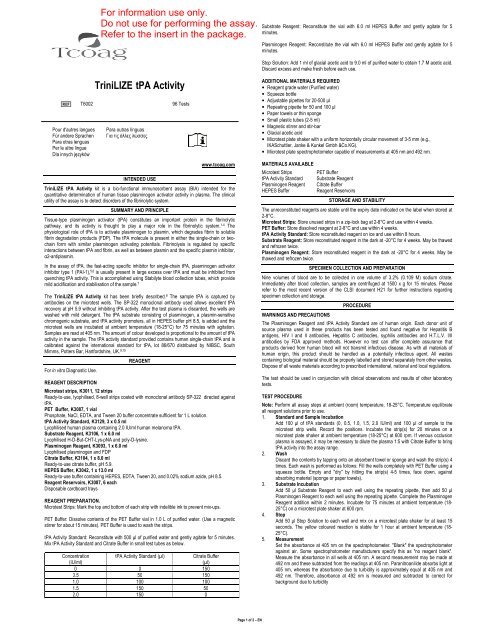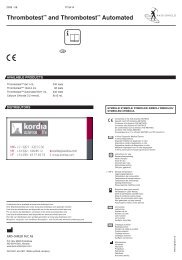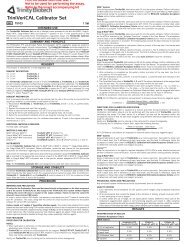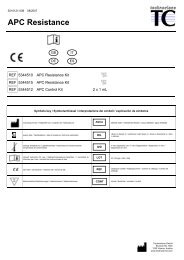TriniLIZE tPA Activity - Stago BNL
TriniLIZE tPA Activity - Stago BNL
TriniLIZE tPA Activity - Stago BNL
Create successful ePaper yourself
Turn your PDF publications into a flip-book with our unique Google optimized e-Paper software.
Pour d'autres langues<br />
Für andere Sprachen<br />
Para otras lenguas<br />
Per le altre lingue<br />
Dla innych języków<br />
<strong>TriniLIZE</strong> <strong>tPA</strong> <strong>Activity</strong><br />
T6002 96 Tests<br />
INTENDED USE<br />
www.tcoag.com<br />
<strong>TriniLIZE</strong> <strong>tPA</strong> <strong>Activity</strong> kit is a bio-functional immunosorbent assay (BIA) intended for the<br />
quantitative determination of human tissue plasminogen activator activity in plasma. The clinical<br />
utility of the assay is to detect disorders of the fibrinolytic system.<br />
SUMMARY AND PRINCIPLE<br />
Tissue-type plasminogen activator (<strong>tPA</strong>) constitutes an important protein in the fibrinolytic<br />
pathway, and its activity is thought to play a major role in the fibrinolytic system. 1-4 The<br />
physiological role of <strong>tPA</strong> is to activate plasminogen to plasmin, which degrades fibrin to soluble<br />
fibrin degradation products (FDP). The <strong>tPA</strong> molecule is present in either the single-chain or twochain<br />
form with similar plasminogen activating potentials. Fibrinolysis is regulated by specific<br />
interactions between <strong>tPA</strong> and fibrin, as well as between plasmin and the specific plasmin inhibitor,<br />
α2-antiplasmin.<br />
In the assay of <strong>tPA</strong>, the fast-acting specific inhibitor for single-chain <strong>tPA</strong>, plasminogen activator<br />
inhibitor type 1 (PAI-1), 5,6 is usually present in large excess over <strong>tPA</strong> and must be inhibited from<br />
quenching <strong>tPA</strong> activity. This is accomplished using Stabilyte blood collection tubes, which provide<br />
mild acidification and stabilisation of the sample. 7<br />
The <strong>TriniLIZE</strong> <strong>tPA</strong> <strong>Activity</strong> kit has been briefly described. 8 The sample <strong>tPA</strong> is captured by<br />
antibodies on the microtest wells. The SP-322 monoclonal antibody used allows excellent <strong>tPA</strong><br />
recovery at pH 5.9 without inhibiting <strong>tPA</strong> activity. After the test plasma is discarded, the wells are<br />
washed with mild detergent. The <strong>tPA</strong> substrate consisting of plasminogen, a plasmin-sensitive<br />
chromogenic substrate, and <strong>tPA</strong> activity promoters, all in HEPES buffer pH 8.5, is added and the<br />
microtest wells are incubated at ambient temperature (18-25°C) for 75 minutes with agitation.<br />
Samples are read at 405 nm. The amount of colour developed is proportional to the amount of <strong>tPA</strong><br />
activity in the sample. The <strong>tPA</strong> activity standard provided contains human single-chain <strong>tPA</strong> and is<br />
calibrated against the international standard for <strong>tPA</strong>, lot 86/670 distributed by NIBSC, South<br />
Mimms, Potters Bar, Hartfordshire, UK. 9,10<br />
For in vitro Diagnostic Use.<br />
REAGENT DESCRIPTION<br />
Para outras línguas<br />
Για τις άλλες λώσσες<br />
REAGENT<br />
Microtest strips, K3011, 12 strips<br />
Ready-to-use, lyophilised, 8-well strips coated with monoclonal antibody SP-322 directed against<br />
<strong>tPA</strong>.<br />
PET Buffer, K3087, 1 vial<br />
Phosphate, NaCl, EDTA, and Tween 20 buffer concentrate sufficient for 1 L solution.<br />
<strong>tPA</strong> <strong>Activity</strong> Standard, K3129, 3 x 0.5 ml<br />
Lyophilised human plasma containing 2.0 IU/ml human melanoma <strong>tPA</strong>.<br />
Substrate Reagent, K3106, 1 x 6.0 ml<br />
Lyophilised H-D-But-CHT-Lys-pNA and poly-D-lysine.<br />
Plasminogen Reagent, K3093, 1 x 6.0 ml<br />
Lyophilised plasminogen and FDP<br />
Citrate Buffer, K3104, 1 x 8.0 ml<br />
Ready-to-use citrate buffer, pH 5.9.<br />
HEPES Buffer, K3042, 1 x 13.0 ml<br />
Ready-to-use buffer containing HEPES, EDTA, Tween 20, and 0.02% sodium azide, pH 8.5.<br />
Reagent Reservoirs, K3087, 6 each<br />
Disposable cardboard trays<br />
REAGENT PREPARATION.<br />
Microtest Strips: Mark the top and bottom of each strip with indelible ink to prevent mix-ups.<br />
PET Buffer: Dissolve contents of the PET Buffer vial in 1.0 L of purified water. (Use a magnetic<br />
stirrer for about 15 minutes). PET Buffer is used to wash the strips.<br />
<strong>tPA</strong> <strong>Activity</strong> Standard: Reconstitute with 500 µl of purified water and gently agitate for 5 minutes.<br />
Mix <strong>tPA</strong> <strong>Activity</strong> Standard and Citrate Buffer in small test tubes as below.<br />
Concentration<br />
<strong>tPA</strong> <strong>Activity</strong> Standard (µl) Citrate Buffer<br />
(IU/ml)<br />
(µl)<br />
0 0 150<br />
0.5 50 150<br />
1.0 100 100<br />
1.5 150 50<br />
2.0 150 0<br />
Page 1 of 2 – EN<br />
Substrate Reagent: Reconstitute the vial with 6.0 ml HEPES Buffer and gently agitate for 5<br />
minutes.<br />
Plasminogen Reagent: Reconstitute the vial with 6.0 ml HEPES Buffer and gently agitate for 5<br />
minutes.<br />
Stop Solution: Add 1 ml of glacial acetic acid to 9.0 ml of purified water to obtain 1.7 M acetic acid.<br />
Discard excess and make fresh before each use.<br />
ADDITIONAL MATERIALS REQUIRED<br />
• Reagent grade water (Purified water)<br />
• Squeeze bottle<br />
• Adjustable pipettes for 20-500 µl<br />
• Repeating pipette for 50 and 100 µl<br />
• Paper towels or thin sponge<br />
• Small plastic tubes (2-5 ml)<br />
• Magnetic stirrer and stir-bar<br />
• Glacial acetic acid<br />
• Microtest plate shaker with a uniform horizontally circular movement of 3-5 mm (e.g.,<br />
IKASchuttler, Janke & Kunkel Gmbh &Co.KG).<br />
• Microtest plate spectrophotometer capable of measurements at 405 nm and 492 nm.<br />
MATERIALS AVAILABLE<br />
Microtest Strips PET Buffer<br />
<strong>tPA</strong> <strong>Activity</strong> Standard Substrate Reagent<br />
Plasminogen Reagent Citrate Buffer<br />
HEPES Buffer Reagent Reservoirs<br />
STORAGE AND STABILITY<br />
The unreconstituted reagents are stable until the expiry date indicated on the label when stored at<br />
2-8°C.<br />
Microtest Strips: Store unused strips in a zip-lock bag at 2-8°C and use within 4 weeks.<br />
PET Buffer: Store dissolved reagent at 2-8°C and use within 4 weeks.<br />
<strong>tPA</strong> <strong>Activity</strong> Standard: Store reconstituted reagent on ice and use within 8 hours.<br />
Substrate Reagent: Store reconstituted reagent in the dark at -20°C for 4 weeks. May be thawed<br />
and refrozen twice.<br />
Plasminogen Reagent: Store reconstituted reagent in the dark at -20°C for 4 weeks. May be<br />
thawed and refrozen twice.<br />
SPECIMEN COLLECTION AND PREPARATION<br />
Nine volumes of blood are to be collected in one volume of 3.2% (0.109 M) sodium citrate.<br />
Immediately after blood collection, samples are centrifuged at 1500 x g for 15 minutes. Please<br />
refer to the most recent version of the CLSI document H21 for further instructions regarding<br />
specimen collection and storage.<br />
WARNINGS AND PRECAUTIONS<br />
PROCEDURE<br />
The Plasminogen Reagent and <strong>tPA</strong> <strong>Activity</strong> Standard are of human origin. Each donor unit of<br />
source plasma used in these products has been tested and found negative for Hepatitis B<br />
antigens, HIV I and II antibodies, Hepatitis C antibodies, syphilis antibodies and H.T.L.V. I/II<br />
antibodies by FDA approved methods. However no test can offer complete assurance that<br />
products derived from human blood will not transmit infectious disease. As with all materials of<br />
human origin, this product should be handled as a potentially infectious agent. All wastes<br />
containing biological material should be properly labelled and stored separately from other wastes.<br />
Dispose of all waste materials according to prescribed international, national and local regulations.<br />
The test should be used in conjunction with clinical observations and results of other laboratory<br />
tests.<br />
TEST PROCEDURE<br />
Note: Perform all assay steps at ambient (room) temperature, 18-25°C. Temperature equilibrate<br />
all reagent solutions prior to use.<br />
1. Standard and Sample Incubation<br />
Add 100 µl of <strong>tPA</strong> standards (0, 0.5, 1.0, 1.5, 2.0 IU/ml) and 100 µl of sample to the<br />
microtest strip wells. Record the positions. Incubate the strip(s) for 20 minutes on a<br />
microtest plate shaker at ambient temperature (18-25°C) at 600 rpm. If venous occlusion<br />
plasma is assayed, it may be necessary to dilute the plasma 1:5 with Citrate Buffer to bring<br />
<strong>tPA</strong> activity into the assay range.<br />
2. Wash<br />
Discard the contents by tapping onto an absorbent towel or sponge and wash the strip(s) 4<br />
times. Each wash is performed as follows: Fill the wells completely with PET Buffer using a<br />
squeeze bottle. Empty and "dry" by hitting the strip(s) 4-5 times, face down, against<br />
absorbing material (sponge or paper towels).<br />
3. Substrate Incubation<br />
Add 50 µl Substrate Reagent to each well using the repeating pipette, then add 50 µl<br />
Plasminogen Reagent to each well using the repeating pipette. Complete the Plasminogen<br />
Reagent addition within 2 minutes. Incubate for 75 minutes at ambient temperature (18-<br />
25°C) on a microtest plate shaker at 600 rpm.<br />
4. Stop<br />
Add 50 µl Stop Solution to each well and mix on a microtest plate shaker for at least 15<br />
seconds. The yellow coloured reaction is stable for 1 hour at ambient temperature (18-<br />
25°C).<br />
5. Measurement<br />
Set the absorbance at 405 nm on the spectrophotometer. "Blank" the spectrophotometer<br />
against air. Some spectrophotometer manufacturers specify this as "no reagent blank".<br />
Measure the absorbance in all wells at 405 nm. A second measurement may be made at<br />
492 nm and these subtracted from the readings at 405 nm. Paranitroanilide absorbs light at<br />
405 nm, whereas the absorbance due to turbidity is approximately equal at 405 nm and<br />
492 nm. Therefore, absorbance at 492 nm is measured and subtracted to correct for<br />
background due to turbidity
PROCEDURAL NOTES AND PRECAUTIONS<br />
1. Human fluids other than plasma have not been tested.<br />
2. Plasma obtained with the usual citrate and EDTA blood collection tubes will typically give<br />
results which are abnormally low due the presence of PAI-1, the fast-acting inhibitor of <strong>tPA</strong>,<br />
in blood. 6<br />
QUALITY CONTROL<br />
It is recommended that two mid-range plasma samples (0.25-1.50 IU/ml <strong>tPA</strong>), collected with a<br />
Stabilyte tube, are used as a quality control check each time the assay is performed. Do not use<br />
the <strong>tPA</strong> <strong>Activity</strong> Standard provided to construct the standard curve to check device performance.<br />
EXPECTED RESULTS<br />
RESULTS<br />
The <strong>tPA</strong> activity in plasma varies. For healthy humans the basal level is between 0.2-2 IU/ml. 11<br />
<strong>tPA</strong> activities for healthy individuals following venous occlusion are reported to be 1.4-14 IU/ml. 1<br />
CALCULATION OF RESULTS<br />
Calibration<br />
The <strong>TriniLIZE</strong> <strong>tPA</strong> <strong>Activity</strong> kit standard curve was correlated to the International <strong>tPA</strong> activity<br />
standard lot 86/670 (NIBSC), resulting in a correlation coefficient of 1.0 with a slope of 1.13.<br />
Plot A405 or A405-A492 against each 0, 0.5, 1.0, 1.5, 2.0 IU/ml standard. Fit a straight line to the<br />
points by a minimum least square procedure. The <strong>tPA</strong> activity in the patient’s plasma specimen<br />
can be determined by interpolation from the standard curve. Results from samples diluted 1:5 with<br />
Citrate Buffer should be multiplied by 5 for the <strong>tPA</strong> concentration.<br />
Example of a sample calibration curve<br />
THE CALIBRATION CURVE SHOWN IS A SAMPLE ONLY.<br />
Users must construct a standard curve each time the assay is performed.<br />
LIMITATIONS<br />
Abnormalities in <strong>tPA</strong> levels have been observed in the following conditions:<br />
1. Venous Thrombosis: In patients with deep vein thrombosis, pulmonary embolism or<br />
superficial thrombophlebitis, a large percentage demonstrated abnormally low <strong>tPA</strong> activity<br />
following provocative testing. 1,3,4<br />
2. Pregnancy: <strong>tPA</strong> levels, as well as PAI levels, increase during pregnancy. 12<br />
3. Post-operatively: <strong>tPA</strong> abnormalities have been observed that may have value for<br />
prediction of deep vein thrombosis. 13,14<br />
PERFORMANCE CHARACTERISTICS<br />
The user should establish product performance characteristics for the specific instrumentation<br />
used.<br />
Precision<br />
Within run and run to run precision was determined at two different levels of <strong>tPA</strong>.<br />
Sample containing 1.3 IU/ml: CV=3.9% (within run, n=20)<br />
CV=5.2% (run to run, n=10)<br />
Sample containing 0.45 IU/ml: CV=7.0% (within run, n=20)<br />
CV=5.3% (run to run, n=10)<br />
Accuracy<br />
The <strong>TriniLIZE</strong> <strong>tPA</strong> <strong>Activity</strong> kit was compared to the Spectrolyse fibrin kit on 75 patient samples<br />
ranging from 0.02 to 2.75 IU/ml <strong>tPA</strong>. The correlation coefficient was 0.981; y = 1.009 x + 0.0526.<br />
Sensitivity<br />
Assay sensitivity is ensured by acidification of the sample during blood draw, which neutralises<br />
plasminogen activator inhibitors as well as plasmin inhibitors. The standard curve is linear between<br />
0 and 2.0 IU/ml. The assay is insensitive to plasminogen and fibrinogen. 6,15<br />
Specificity<br />
Assay specificity is ensured by the stimulators poly-lysine and FDP. Under assay conditions, these<br />
stimulators increase the activity of <strong>tPA</strong> on plasminogen about 300-fold, but have no effect on<br />
urokinase. 15 Specificity of the method is indicated by the ability of specific antibodies to <strong>tPA</strong> to<br />
quench activator activity. 15<br />
Page 2 of 2 – EN<br />
REFERENCES<br />
1. Wiman B et al.: The role of the fibrinolytic system in deep vein thrombosis. J Lab Clin Med<br />
105: 265-270, 1985.<br />
2. Mellbring G et al.: Relationship between preoperative status of the fibrinolytic system and<br />
occurrence of deep vein thrombosis after major abdominal surgery. Thromb Res 39: 157-<br />
163,1985.<br />
3. Nilsson IM et al.: Two different mechanisms in patients with venous thrombosis and<br />
defective fibrinolysis: low concentration of plasminogen activator or increased concentration<br />
of plasminogen activator inhibitor. Br Med J 290: 1453-1456,1985.<br />
4. Juhan-Vague I et al.: Deficient t-PA release and elevated PA inhibitor levels in patients with<br />
spontaneous or recurrent deep vein thrombosis. Thromb Haemostas 57: 67-72,1987.<br />
5. Chmielewska J et al.: Evidence for a rapid inhibitor to tissue plasminogen activator in<br />
plasma. Thromb Res 31: 427-436,1983.<br />
6. Chmielewska J et al.: Determination of tissue plasminogen activator and its fast inhibitor in<br />
plasma. Clin Chem 32: 482-485,1986.<br />
7. Rånby M et al.: Blood collection in strong acidic citrate anticoagulant used in a study of<br />
dietary influence on basal <strong>tPA</strong> activity. Thromb Haemostas 62: 917-922,1989.<br />
8. Rånby M et al.: A Bio-functional Immunoassay, BIA, for Tissue Plasminogen Activator, <strong>tPA</strong>.<br />
Lieden Workshop on Fibrinolysis April, 1994.<br />
9. Gaffney PJ et al.:A Collaborative Study to Establish the 2nd International Standard for<br />
Tissue Plasminogen Activator (t-PA). Thromb Haemostas 58(4): 1085-1087, 1987.<br />
10. Rånby M : On the Properties of the International Standards for Tissue Plasminogen<br />
Activator Thromb Haemostas 63(1): 139, 1990.<br />
11. Eliasson et al.: Influence of Gender, Age and Sampling Time on Plasma Fibrinolytic<br />
Variables and Fibrinogen. Fibrinolysis 7: 316-323,1993.<br />
12. Kruithof E et al.: Fibrinolysis in pregnancy; a study of plasminogen activator inhibitors.<br />
Blood 69: 460-466,1987.<br />
13. Paramo J et al.: Postoperative changes in the plasmatic levels of tissue type plasminogen<br />
activator and its fast-acting inhibitor. Relationship to deep vein thrombosis and influence of<br />
prophylaxis. Thromb Hemostas 54: 713-716,1986.<br />
14. Kluft C et al.: Association between post-operative hyperresponse in t-PA inhibition and<br />
deep vein thrombosis. Thromb Haemostas 56: 107,1986.<br />
Rånby M et al.: A sensitive assay for tissue plasminogen activator. Thromb Res 27: 743-<br />
749,1982.<br />
ORDERING INFORMATION<br />
KIT <strong>TriniLIZE</strong> <strong>tPA</strong> <strong>Activity</strong><br />
Catalogue No. Item Quantity<br />
T6002 <strong>TriniLIZE</strong> <strong>tPA</strong> <strong>Activity</strong> 96 Tests<br />
Tcoag Ireland Limited,<br />
IDA Business Park,<br />
Southern Cross Road,<br />
Bray, Co. Wicklow,<br />
Ireland.<br />
Tel. + 353 1 2743200<br />
Fax +.353 1 2746678<br />
www.tcoag.com<br />
info@tcoag.com<br />
T6002 -29 Rev C<br />
02/2011







